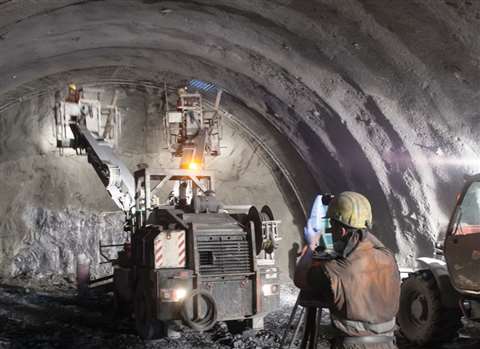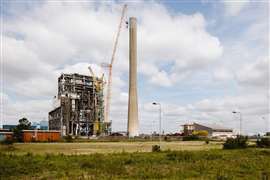Tunnelling: Going underground
02 December 2015

Completion of running tunnels for London’s huge Crossrail scheme was a major highlight this year, as the last of eight Herrenknecht TBMs (tunnel boring machines) broke through in May, meaning that 21km of new twin bore tunnel has now been threaded through complex cluttered ground beneath Britain’s capital.
The last TBM, Victoria, completed one of two parallel 8.3km bores from the east to Farringdon Station in central London – the longest drives. Six 7.1m diameter EPBs (earth pressure balance) worked on the project which also used two slurry type Mixshields for a crossing under the River Thames. Work to dismantle Victoria began in the summer.
The tunnels are the central element of the overall £14.8 billion (€20.5 billion) project which forms a new 118km long link from the east to the west of London. There are expected to be 200 million passengers annually.
Work continues on station caverns, primarily with spray concrete methods, and fitting out for both stations and rail. Trains are due to run at the end of 2018.
London’s tunnellers have another project to occupy them – the huge £4.2 billion (€5.8 billion) Thames Tideway interceptor, a 25km long sewage overflow storage and transport tunnel, 7.2m diameter running up to 65m deep, mostly underneath the river. It will eliminate storm overflow into the river from 34 existing sewers.
The seven-year construction starts next year, overseen by specially-created independent company Balzagette Tunnel for utility company Thames Water. Contractors selected include major European firms BAM Nuttall, Ferrovial Agroman, Balfour Beatty, Costain and Vinci Construction.
Second largest
The second largest project in Europe is the Stuttgart 21 underground station and rail scheme in Germany, and the associated Stuttgart-Ulm high-speed rail project, both of which involve multiple tunnels. Taken together, they are costing around €10 billion. Both are now significantly into construction after years of controversy and protest.
The city project is building a new central station, underground in the heart of the city, with eight tracks running at 90º to the orientation of the 15-platform existing station. The client, Deutsche Bahn, said that despite fewer lines, the through nature of the station was quicker and faster than the existing in-out terminus, which funnels into just five exit lines.
The project involves reconfiguring local and regional lines with a series of radiating soft ground tunnels in the city, which is enclosed by hills on three sides. Complex work is needed beneath buildings and a river crossing.
There is also a new high-speed rail link running out southeast through the largest of the tunnels, the 9.5km hard rock Filder tunnel which is currently being driven.
Austrian contractor Porr is working from the southern portal, using TBM drives and a central 1.5km long section of drill and blast. The drill and blast is needed to pass through anhydrite Keuper gypsum which must be kept dry to avoid expansive reaction with water which could trap a machine. Special water seals have to be installed around the tunnel bores.
Work on the first bore began in autumn last year using a 10.82m Herrenknecht multimodal machine, in EPB mode. Spoil goes to the surface with a Swiss Agir conveyor for immediate loading for truck disposal from a tightly constrained worksite. To save space, segments arrive on a just-in-time basis by train from precast works operated by contractor Max Bögl near Berlin.
The first 4.5km is just finished, and the TBM is being dismantled and moved to the portal for a parallel drive beginning next spring. Atlas Copco rigs are starting the centre sections. After its second drive the TBM will be hauled through the conventional sections for two more drives at the far end.
At this city end, meanwhile, large NATM (new Austrian tunnelling method) caverns are being made for the TBM reception and turn, and for link tunnels into the station. Sophisticated compensation grouting is needed to stop the settlement of buildings above the tunnel. Specialist consultant Professor Walter Wittke is advising on the tunnel and this work.
Five tunnels
He is also working on the high speed link to Ulm, which continues from where the Filder finishes at the airport with another 60km of new line. Some five major tunnels are required, several in construction for the last three years.
The biggest are under the Schwabian Alps, a highland national park where two tunnels, totalling 14km take the line upwards and another, the 5.5km long Albabstieg, descends into Ulm.
Difficult karstic limestone and squeezing conditions are being tackled for the first ascending tunnel – the Bossler. Part of this is driven by an 11.3m Herrenknecht TBM, while the remainder is using drill and blast methods. The same Porr-led joint venture is doing this work.
It has also just completed the 4.8km long Steinbühl tunnel, which continues the upward climb after a 485m bridge over a narrow valley. Despite further difficult karstic limestone sections, this twin bore has gone well and breakthrough was due to be celebrated on 6 November, six month ahead of schedule.
A further soft ground tunnel of 7km is still in preparation along the line.
Even bigger high speed tunnels are underway through the Alps linking northern Europe to Italy.
The largest is the world record 57km long Gotthard Base tunnel, up to 2,500m deep, where track laying is complete and the opening is expected to be in June next year.
The AlpTransit scheme includes a second tunnel further south, the 15.4km long twin-bore Ceneri where drill and blast operations with Sandvik rigs and a Rowa backup system are nearly complete. This was one of the first major projects for Agir conveyors.
Two southern drives were completed in March and more difficult 8km northern drives will finish by the end of the year when rail and signalling work begins. The Ceneri will shave a further 10 minutes from the Zurich to Milan route when complete.
Austria to Italy
Meanwhile, attention has moved to Austria and Italy where not only the great Brenner Pass base tunnel is well underway, but two more base tunnels as well – Koralm and Semmering.
The Brenner, from Tyrolean capital Innsbruck to Fortezza in Italy, forms part of the Trans-European Network (TEN-T) route from Berlin to Palermo. It is comparable to Gotthard at 55km long and has a maximum cover of 1,800m. If taken together with a 9km linked bypass tunnel at Innsbruck for trains heading onwards, it will claim a world record length of 64km.
Between two single-track main bores of 8.1m in diameter there is a smaller central service tunnel of just under 5m inner diameter and running 12m lower. It serves for later maintenance and drainage but is also vital for exploration and geological investigation, according to the client, the Austro-Italian Brenner Base Tunnel company.
Preparation for the main tunnel drives has been underway for several years, with five major access adits virtually complete, including a 6km length of the exploratory from Innsbruck. The most important work recently has been a 1.5km long, conventionally excavated section across the Periadriatic fault on the Italian side. This tectonically crumbled rock was potentially a major obstacle, but while the fractured rock was difficult going, it has proved passable. The same contract, completed this year also excavated and lined the first two 1.5km sections of the main bores.
The next major work is an additional 15km of exploratory tunnel being made with a Herrenknecht gripper TBM southwards from the initial Innsbruck section. It started this October after assembly in an underground cavern.
The €380 million multipart contract was let to Austrian contractor Strabag with Salini Impregilo from Italy in September last year. Work also includes completing more access points in the Innsbruck area, and a long 9km drill and blast drive parallel to the bypass tunnel as a safety tunnel.
Austria has another trans-European high speed link underway, upgrading the line from Vienna to Graz, and with an entire new line section onwards to Klagenfurt.
A key feature of the link is the 32.8km Koralm tunnel with maximum cover of 1,200m, and like other base tunnels it has a very flat gradient. Apart from a small 1.5km portal section begun in 2011, it is being driven in two main contracts.
The largest is by contractor Strabag and joint venture partner Jägerbau with 20km to do. A first section of around 3km was in soft ground while the rest is parallel hard rock drives – one of 16km and one 17m, both with segmental linings.
Begun two years ago, these have proved slow going in hard and often blocky rock, though the contractor is pleased with its two “tough” CREG-Wirth TBMs now over 11km in. The client, Austria’s Federal Railways civil engineering company ÖBB Infrastruktur, has said that things are within the parameters of the contract for the eventual 2018 completion.
The remaining approximately 12km of tunnel was let last year to Porr, and is being driven by conventional methods in one tube, where half was excavated in the investigation stage, and by a multimode Herrenknecht TBM on the full length of the other bore.
North of Graz, meanwhile, the 27km long Semmering is just starting. Cutting under the historic but speed- and gradient-limited Semmering mountain railway, it will also provide a flat gradient for high speed trains.
Because of exceptionally complex geology and high water heads, investigated in detail over the last decade, the tunnel is divided into several sections, mostly to be built by conventional means. Contracts are currently being let.
Only one central section of 9km can be done by TBM, starting from a cavern at the base of a 400m deep shaft currently under construction by a joint venture of Implenia and Svedelski. Some 4.4km of conventional drive will head in the other direction from the shaft cavern.
A 7.4km section from Gloggnitz at the east portal has been let to Hochtief Infrastructure Austria, Implenia Austria and Thyssen Schachtbau for €457 million. Work will go from the portal and an access shaft.
Cross border
One final trans-European base tunnel route is the 57km Lyon to Turin cross-border project. Final go ahead was agreed in February between France and Italy. An EU subsidy of 40% of the €8.8 billion cost, was agreed in July.
The tunnel between St Jean-de-Maurienne in French Savoy and the Susa valley in the Piedmont will have twin bores with a separation of 30m. The inner diameter will be 8.4m – slightly larger than Gotthard and Brenner – allowing clearance for lorry shuttle trains.
There had been work on access and exploratory tunnels completed in recent years but full commitment to the scheme has been uncertain until now.
A fourth access and exploratory adit on the Italian side is still in excavation and about half complete. It began later in 2013 because work had previously been disrupted by hostile demonstrations. This Maddalena tunnel site still has a police guard.
It is using a 6.3m diameter Robbins main beam TBM both to test possible TBM drive conditions and gather rock data.
On the French side, another test tunnel contract has just been let to Spie Batignolles, for a 9km section of one of the two main bores. It will use an NFM TBM with overcutting facility to explore rock conditions and possible squeezing ground.
Moving further north, Norway is currently excavating the deepest ever undersea road tunnel – the 14.3km Solbakk tunnel at Stavanger – reaching 290m depth. It is part of a three tunnel scheme for the coastal city, the Ryfast, and is being driven by drill and blast through hard gneiss and softer phyllite claystone.
Atlas Copco rigs with Volvo loaders and trucks are in use for one of the two contracts while Swiss firm Marti on the eastern 7.8km section is using Sandvik rigs and, for the first time in Norway, a conveyor muck system, supplied by sister firm, Marti Technik.
An even bigger and deeper road tunnel from Stavanger northwards, the Rogfast, is currently in design.
Meanwhile, at Bergen, a Herrenknecht hard rock gripper TBM is just being readied for a 7km drive through very hard granite for the Ulriken tunnel at the end of the Bergen to Oslo rail line. It is the first TBM drive for a rail tunnel in Norway.
Joint venture contractor Skanska-Strabag will also use conveyors for spoil, this one from Agir.
The tunnel will double track an existing single bore open since 1964. Work began last year with an initial 800m drill and blast section for track crossover and line branching into platforms on a station at Arna. An Atlas Copco rig drilled and Volvo wheeled loaders and trucks moved out the spoil.
High-speed rail
Norways’ biggest project is the Follo high-speed rail line from Oslo to commuter town Ski, mostly in a 20km twin-bore tunnel.
Contractors Acciona and Ghella have ordered four Herrenknecht TBMs to begin excavation work late next year. Another contract with Italian contractor Condotte d´Acqua will use “drill and split”, the first use of the method in Norway which replaces blasting with hydraulic wedges to remove rock.
Sweden began work early this year on the huge ten-year Stockholm bypass scheme which will put a dual three-lane motorway underground on the west side of the city through typical Scandinavian hard rock.
Czech firm Subterra is making the access tunnels, and contracts for major work beginning next year are with Implenia, Skanska and Norway’s Veidekke.
Finally, literally on the edge of Europe, this autumn saw breakthrough of the spectacular 5.4km long Eurasia tunnel, a twin-deck dual two-lane road tunnel underneath the Bosporus in Istanbul, Turkey, which has taken high pressure working to a new level.
A giant Herrenknecht Mixshield drove the central 3.34km section in both saturated soft ground and rock at maximum depth of 106m with pressures at an unprecedented 12bar.
STAY CONNECTED


Receive the information you need when you need it through our world-leading magazines, newsletters and daily briefings.
CONNECT WITH THE TEAM










